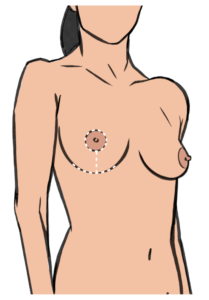|
Procedure
|
After breast implant surgery, scar tissue (=capsule) surrounding the implant can cause discomfort and aesthetic concerns. This is a natural process and happens after about 10-15 years.
Women over 50 or women with a strong family history of breast cancer should have a breast cancer screen prior to aesthetic surgery.
The breast implant is removed with the surrounding scar tissue (=capsulectomy) where possible. The surgery is more complex than the original insertion of the implants. An additional breast lift improves the shape where ptosis (=droopiness) following surgery is a concern. Breast lift scars are usually anchor shaped = around and underneath the areola.
I do not use drains routinely. The wounds are repaired with sutures under the skin which do not require removal and dissolve within four months. A support garment following surgery is recommended.
A fluid collection after more than a year following implant surgery can be an indicator of BIA-ALCL (Breast Implant Associated – Anaplastic Large Cell Lymphoma) which is a rare cancer associated with rough (=textured) implants. The usual treatment is removal of the implant and a total capsulectomy. Histology testing of the capsule is mandatory in all suspicious cases and should be considered by patients in all other cases (Please let your surgeon know if you prefer testing).
|
|
Scars
|
Anchor shaped: Around areola & vertical below areola & in breast fold
|
|
Operation time
|
3 hours
|
|
Anaesthesia
|
General
|
|
Hospital Stay
|
Day Surgery > (Overnight)
|
|
Benefits
|
Aesthetic, Psychological, Functional, Symptomatic
|
|
Risks
|
Bleeding, Infection, Scar problems (stretched, thick, abnormal pigmentation, red, retracted etc.), Skin discoloration, Skin cones, Skin penetration, Wound separation, Slough, Necrosis (Nipple / skin / fat), Pain, Nerve injury (Numbness, weakness), Bruising, Swelling, Overcorrection, Undercorrection, Asymmetry, Remaining stretch marks, Recurrent redundancy / droopiness, Aesthetic imperfections (higher risk after subsequent pregnancies / weight changes / menopause), Seroma, Shoulder problems, Pneumothorax, Inability to breastfeed, Contour irregularities, Unfavourable nipple shape / position, Need for further surgery, Allergic reaction, Chest infection, Heart attack, Stroke, Blood clots in legs & lungs. N.B. Most complications are unlikely. Serious risks or death are rare
|
|
Risk factors
|
Alcohol, Breastfeeding over last 6 months, Poor tissue quality can cause recurrent laxity, Asymmetry cannot be entirely corrected, Too early or excessive mobilisation, Wound interference without surgeon's agreement;
Contraindications which preclude surgery unless discussed otherwise in the consultation:
Smoking / vaping / nicotine / recreational inhalations within 6 weeks before and after surgery,
Contraception with estrogens or HRT tablets (if under general anaesthetic),
Air travel over 2 hours within 6 weeks before and after surgery (if under general anaesthetic),
Air travel under 2 hours within 2 weeks before and after surgery,
Overweight (Body Mass Index = BMI of 27 and over),
Recent weight changes over 6kg,
Pregnancy (if under general anaesthetic),
Raised blood pressure (if poorly controlled),
Bleeding tendency (Stop herbal products or supplements for two weeks before surgery),
Diabetes or immunosuppression (if poorly controlled)
|
|
Optimising factors
|
Diet rich in Vitamin C and protein, plenty of fluids, fresh air, sufficient sleep, scar massage, sun protection, silicone sheets / gel, support garments
|
|
Discomfort
|
1 - 2 weeks
|
|
Bruising
|
2 - 3 weeks
|
|
Recovery
|
Light activities 2 weeks, Driving 3 weeks, Physical work & sports & sex 6 weeks, Unrestricted 3 months
|
|
Acceptable appearance
|
2 - 4 weeks for most patients (This is subjective)
|
|
Final result
|
6 -18 months
|
|
Alternatives
|
No Surgery, Garments, Implant removal without lift
|


